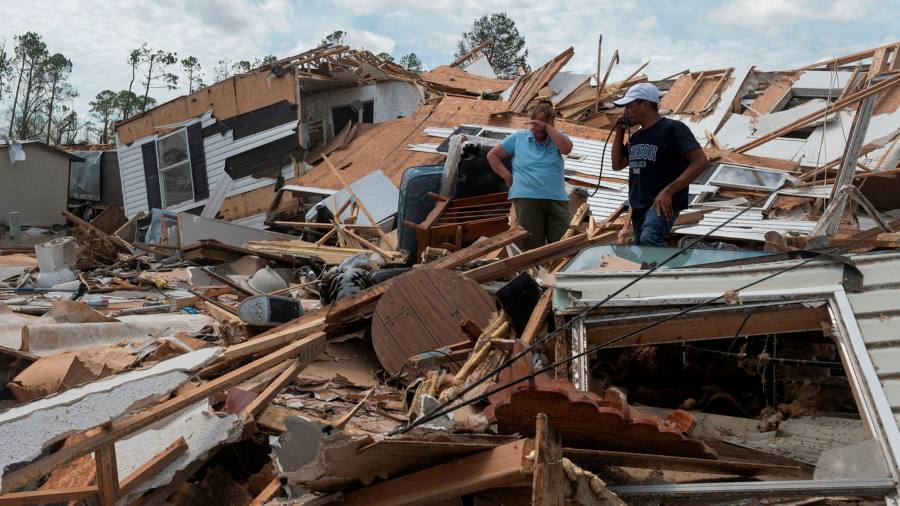[ad_1]
The writer is a science commentator
It would be unthinkable for a hurricane to hit the US without warning — or for modellers to be hurriedly convened only once the tempest had reached land. The National Weather Service is on permanent watch for these and other natural hazards, whose destructive paths can be predicted several days ahead of time using a mix of observational data and atmospheric modelling finessed over decades.Â
Now the US is setting up a forecasting service that aims to do for diseases what the weather service does for meteorology. The day after his inauguration, Joe Biden announced the creation of the National Centre for Epidemic Forecasting and Outbreak Analytics for “modernising global early warning and trigger systems for scaling action to prevent, detect, respond to, and recover from emerging biological threatsâ€.Â
The centre’s name is strikingly similar to that of an imagined organisation that Caitlin Rivers, an epidemiologist at the Johns Hopkins Center for Health Security think-tank, sketched out in an essay last year for Foreign Affairs. That vision, co-authored with Dylan George, a specialist in biological threats, was for an agency that could bring together disparate strands of expertise relating to infectious disease modelling and give academics a permanent seat at tables where policy and strategy decisions are made. Their National Center for Epidemic Forecasting and Analytics would replace the groups usually thrown together at short notice when an outbreak happens, such as the 2009 H1N1 swine flu pandemic.
The pair envisioned it would also provide a smoother funding channel for critical research. Academics often rely on piecemeal grants and, given that contagion rarely offers the opportunity for profit, there is little incentive for the private sector to make up any shortfall.
Ms Rivers, who testified before Congress last year on pandemics, said she was thrilled at the news: “It’s a major development in outbreak preparedness . . . we face epidemic threats every few years, and seasonal influenza annually. Investing in these capabilities will pay dividends, both for public health and the economy.â€Â The US Centers for Disease Control has flirted with the idea of epidemic forecasting for several years, harnessing the computing power of the Los Alamos National Laboratory to predict the spread of flu and mosquito-borne illnesses such as West Nile fever.
The journal Nature also applauded the initiative. It said every country should similarly consider setting up an “independent body that provides [disease] forecasts using advanced computational power, and the best available dataâ€. Covid-19, however, shows that predicting contagion means joining the dots across national borders. The US government statement also calls on the UN secretary-general’s office to appoint someone specifically to organise global co-operation on biological threats.
For some, though, the analogy between meteorology and epidemiology has its limits. Professor Graham Medley heads infectious disease modelling at the London School of Hygiene and Tropical Medicine and chairs a modelling committee, SPI-M, advising the UK government on the coronavirus pandemic. He cautions that while weather forecasting rests on the laws of physics, disease forecasting is an inherently trickier prospect: “Epidemiology is not physics. A large part of epidemiological modelling is based on human behaviour, which remains largely unpredictable. Most importantly, we need good data streams to understand what people are doing and why.â€
Meteorology is flooded with historical and current data, which bolsters the accuracy of weather forecasting. The practice of recording the climate even features in presidential legacy. From the 1770s onwards, Thomas Jefferson, the third US president, assiduously recorded the weather at his Virginia plantation with the latest thermometers and barometers; he is still regarded as an influential figure in weather observation, and his home, Monticello, is one of thousands of weather stations under the National Weather Service. Today, those traditional efforts are complemented by information gathered by aircraft, weather balloons and satellites.
One advantage offered by a permanent disease forecasting agency is that it allows an ongoing public conversation about pathogens, diseases and the risks they pose. Just as a weather forecast today prompts some to pack an umbrella, perhaps a disease forecast will one day persuade us to don a mask. It would remind us that, just as we coexist with an ever-changing climate, we share the planet with a wealth of opportunistic microbes and viruses.
Â
[ad_2]
Source link






